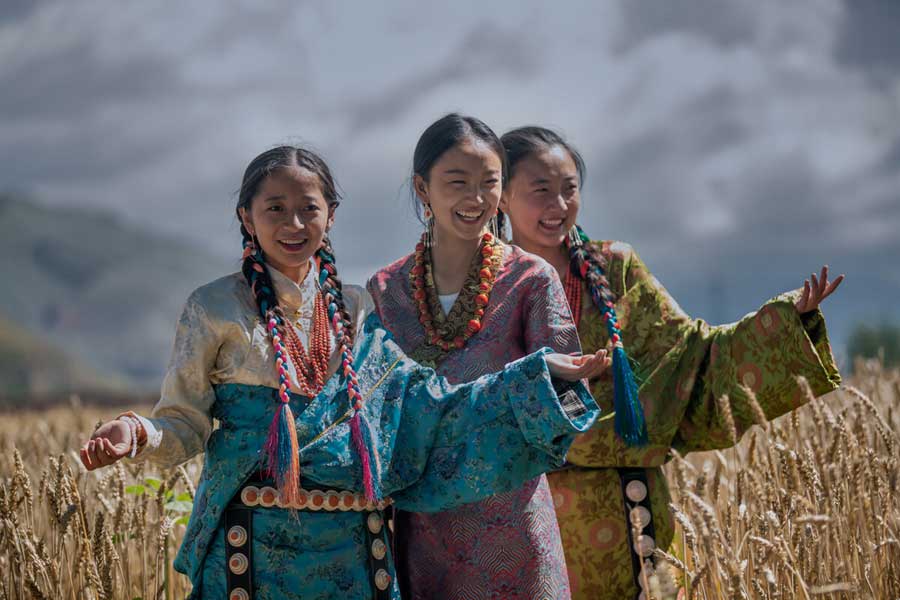More than 4,000 years ago, the ancestors of the Tibetans began to breed in the Yarlung Zangbo River. Tibetans are mainly spread in China, Nepal, India, Bhutan, etc. In China, they’re mainly spread in the Tibet Autonomous Region, Qinghai Province, and the western part of Sichuan Province, and the population of about 6.5 million. Tibetans believe in Tibetan Buddhism. The influence of Tibetan Buddhism on the Tibetan people has penetrated into every aspect of daily life.
Apparel of the Tibetan ethnic group
The basic features of Tibetan costumes are long sleeves, wide waists, long skirts, boots, and Tibetan hats. Costumes are colorful. Their major characteristics are represented in the combination of colors and pictures. Tibetans attach great importance to Hada (a piece of silk, usu. in white color) as the most precious gift.
Food and Drink
Tibetan food is divided into three categories: staple food, dishes, and soup. Ghee, tea, zanba, beef, and mutton are called the “four treasures” of the Tibetan diet, as well as barley wine and various dairy products. The taste of Tibetan food is light and calm, and many dishes, except salt and leek, usually do not put spicy condiments. Zanba is an important food for the Tibetans. Generally, they eat only beef and mutton, not horses, donkeys, and mules, especially not dog meat.
Traditional Festivals and Religion
Tibetan festivals are numerous and almost every month has its own festival. Tibetan January has the most festivals and is the most solemn month. In this month, almost every day has a festival. Tibetan festival is the most important expression of Tibetan culture. Tibetan Buddhism has a history of more than 1,300 years in Tibet, China, and has become a part of the life of the Tibetan people. As a result of its profound influence, Tibetan festivals have become very religious and some of them have evolved into pure religious festivals.
Xue Dun Festival is one of the important festivals of the Tibetan people in Tibet. It is held on the 1st of July each year for three to five days. Xue Dun means “yogurt feast” in Tibetan language, so the Xue Dun Festival is interpreted as the festival of drinking yoghurt. According to the regulations of the Gelug Sect of Tibetan Buddhism (Huang Sect), the Tibetan Calendar is banned from June 15th to 30th each year. Lamas of all sizes of temples are not allowed to go out to avoid trampling on small insects until the ban is lifted on June 30th. As the lama descended from the mountain, the farmers and herdsmen took out yoghurt and offered it as a Xue dun Festival.
Tibetan Ethnic Customs and Taboos
If you see an elder or a respected person, take off your hat and bend it down 45 degrees. Hold the hat in your hand, close to the ground. If you see a person close to your age, lower your head slightly and hold your hat in front of your chest. The bow at this point is only a courtesy. Presenting a Hada is the highest standard of Tibetan hospitality, expressing a warm welcome and sincere respect to the guests.
You should avoid calling others names directly when meeting, and you should add a complimentary modifier before their names to show respect and kindness.
Relationship among Manchu, Mongolian and Tibetan Ethnic Groups
Manchu, Mongolian, and Tibetan ethnic groups have been deeply involved in the historical processes in China. Mongolian and Manchu established dynasties in China one after another, and the Tibetans began to integrate into the Chinese extended family during the Tang Dynasty. Manchu had a close relationship with Mongolian history. The Manchus intermarried with the Mongols for a long period of time in the late Ming Dynasty and established a strong alliance by any means, and destroyed the Ming Dynasty and established the Qing Dynasty under the strong support of the Mongolians. Most of the daughters of Mongolian nobles intermarried with Manchu noblemen, and the Qing Dynasty queens were Mongolian women, so there was the saying “Manchu Mongolian family”. After a long period of friendly exchanges, the two nations have a lot in common in religious beliefs, cultural practices,s and so on. For example, the Manchu letter is borrowed from the Mongolian script system transformation and the Buddhist faith of Manchu was also deeply influenced by Mongolian Lamaism.

